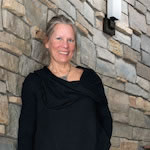gb&d: Today, you’re an accomplished architect with a passion for sustainability. You just completed a LEED Platinum home and have created many others that are leaders in energy efficiency. What first drew you to green building?
Virge Temme: In 1992, I worked at the Army Corp of Engineers while going to grad school. I was part of a team that designed a fully sustainable neighborhood in Texas for one of the military bases. Through that experience, I learned about climate-specific design. When I finished, all I could think was, “Why isn’t everybody doing this?” When I started my practice in Door County, Wisconsin, I wanted to make sure that the homes I designed were environmentally responsible.

Temme founded Virge Temme Architecture in Sturgeon Bay, WI, in 1999. Today, she practices out of her home in scenic Door County, WI, and is an active member of the USGBC and the Passive House Alliance. In terms of square feet, her house is smaller than her garden.
gb&d: Can you pinpoint any influences on how you approach design?
Temme: I had the great privilege of being a student assistant for one of the world’s leading authorities on Japanese architecture, Botond Bognar. The Japanese approach design from the basis of impacting the senses—creating spaces that influence your mood and provide balance and harmony. When I design any project, I start with understanding the inhabitants’ lifestyle—what elevates their own unique senses.
gb&d: What would you say is your design philosophy?
Temme: I design both for the senses and a lower impact on the Earth. My life philosophy is that we’re here to learn and to contribute beneficial acts. I want the homes I design to reflect that, to be thoughtful and beneficial.
gb&d: You’re practicing what you preach with your own home. Why is that important?
Temme: I use my home as a teaching tool. People who visit my home cannot believe that it’s actually only 1,800 square feet, because it feels much larger. I walk people through spaces that are completely furnished so they can easily see that they don’t need as much space as they thought.
gb&d: Besides living in an Earth-friendly home, what do you do to live a green lifestyle?
Temme: I’m a big supporter of the local food movement. I have a 2,000-square-foot vegetable garden and an edible landscape. Much of the food we eat is out of our backyard. I also started the Hundred Mile Food Challenge in Door County. Fourteen families committed to eating only food grown within a hundred-mile radius for one year. We raised the consciousness about local farmers. In fact, the University of Wisconsin Extension office reported that during that year, farmers’ local sales increased by over twenty percent because of the added exposure.
gb&d: Besides eating more responsibly, what else can people do if they want to minimize their impact or live more consciously?

Economizing space and designing to inhabitants’ lifestyles also are constant priorities for Temme, who primarily works in Wisconsin.
Temme: We can affect the environment through many small actions, like whether we recycle or how many unnecessary items we purchase. I find I rarely buy anything spontaneously anymore. The vehicles we drive also have a large impact. I drive a Prius that gets 50 miles per gallon, and my Honda Phantom motorcycle gets 60. Five years ago, I moved my office back home because I was commuting 25 miles every day to go to my office, which needlessly put about four tonnes of carbon into the atmosphere every year.
gb&d: What allows you to work from home?
Temme: Our rural area got high-speed Internet about five years ago, which enabled me to work from home. And technology has improved to the point that my office is virtually paperless, so I need much less space.
gb&d: You also advocate for a sustainable lifestyle outside of your practice and home. Can you speak a little on that?
Temme: A few years ago, I started writing a bimonthly column for the local newspaper to inform people what was going on in green architecture. Although I became too busy with my practice to continue the column, it transformed into a regular “green lifestyle” feature that still exists today and is positively affecting the community.
gb&d: Let’s talk about recent projects. Ithaca, Double Scoop, and Lake Farm—how do these homes exemplify your work?

The Virge Temme-designed Ithaca home in Wisconsin, uses Passive House strategies and is LEED Platinum certified.
Temme: Ithaca earned LEED Platinum, but all three follow the template of LEED for Homes. They were all modeled using Passive House software, are near-Passive House levels in performance, and are prepped for PV electric and solar domestic water. These strategies have become mainstays in nearly all my designs.
gb&d: What advice do you have for people who are looking to build more sustainably?
Temme: The single most important thing a homeowner can do is create the best possible building envelope. Install the most energy-efficient windows the budget will allow, maximize insulation, eliminate thermal bridging, and seal everything well. It’s equally important to work with a builder who understands why this is important and knows how to properly carry it through. This will reduce energy bills and allow for upgrades in other areas if desired.
gb&d: From a holistic perspective, what is the important takeaway from your work in sustainable design?
Temme: Education is pivotal and primary for my clients, builders, and myself. Keeping current on changing studies in green technology is key. There’s also a field of study called environmental psychology that I try to keep abreast of, which is the overlapping of human psychology with nature. When I decide to retire from full-time practice in 10 years, there are a couple of books that I’ve been fleshing out in my mind about this subject that I’m hoping to write.

